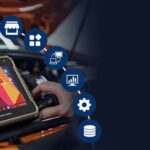An OBD2 mini interface, often utilizing the ELM327 chip, allows you to unlock a wealth of information about your vehicle’s performance, diagnostics, and sensor data. This guide will walk you through how to use this powerful tool effectively.
Understanding the OBD2 Mini Interface
The OBD2 mini interface is a small device that plugs into your vehicle’s OBD2 port, typically located under the dashboard on the driver’s side. It communicates with your car’s computer (ECU) and transmits data wirelessly via Bluetooth or Wi-Fi to your smartphone or tablet. This data can be interpreted using a compatible app, like Car Scanner, transforming your device into a sophisticated diagnostic tool.
Connecting to Your Vehicle
- Locate your OBD2 port: Usually found under the dashboard on the driver’s side.
- Plug in the OBD2 mini interface: Ensure a secure connection.
- Pair your device: Enable Bluetooth or Wi-Fi on your smartphone or tablet and pair it with the interface. Follow the manufacturer’s instructions for the specific pairing process.
- Launch your OBD2 app: Open a compatible application like Car Scanner. The app will establish communication with the interface and begin reading data from your vehicle’s ECU.
Utilizing OBD2 Software
Once connected, OBD2 software provides a wide array of features:
Real-Time Data Monitoring:
- Customizable Dashboards: Display gauges and charts tailored to your needs, showcasing vital metrics like engine speed, coolant temperature, fuel pressure, and more.
- Sensor Data: Access detailed information from various sensors, providing insights into your vehicle’s performance.
Diagnostics and Troubleshooting:
- Read and Reset Fault Codes: Identify and clear Diagnostic Trouble Codes (DTCs), providing clues to potential issues. A comprehensive database of DTC descriptions aids in understanding the codes.
- Freeze Frame Data: Access sensor data captured when a DTC was stored, helping pinpoint the cause of the problem.
- Mode 06 Tests: Retrieve ECU self-monitoring test results for in-depth diagnostics.
Performance Monitoring:
- Acceleration Tests: Measure 0-60 mph, 0-100 km/h, and other acceleration metrics accurately.
- Trip Computer: Track fuel consumption statistics and monitor your driving efficiency.
Vehicle Specific Features:
Many OBD2 apps offer connection profiles tailored to specific car manufacturers, unlocking advanced features like encoding hidden parameters for certain VAG group vehicles (Volkswagen, Audi, Skoda, Seat).
Choosing the Right OBD2 Mini Interface
Selecting a reliable OBD2 adapter is crucial. While inexpensive options are available, opting for a reputable brand like Kiwi 3, Viecar, or V-Gate ensures better performance, stability, and compatibility. Avoid adapters marked as v2.1, as they are known to have bugs.
Conclusion
The OBD2 mini interface empowers you to take control of your car’s maintenance and understand its performance in detail. By following this guide and using a reliable adapter and app, you can transform your smartphone into a powerful diagnostic tool, saving money on repairs and gaining a deeper understanding of your vehicle.

